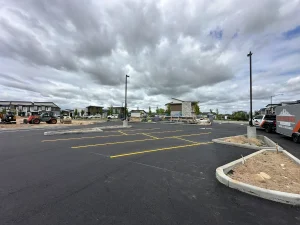The Process of Patching Asphalt (And Why It Matters for Your Pavement)
Your asphalt takes a beating every day—from heavy traffic to changing weather—and over time, even the best-paved surfaces develop cracks, potholes, or deteriorating spots. When that happens, patching becomes essential.
Asphalt patching is more than just a quick fix—it’s a cost-effective way to extend the life of your pavement, improve safety, and protect your investment. Let’s break down the process and why it matters.
What Is Asphalt Patching?
Patching is the process of repairing damaged or deteriorated sections of asphalt by removing the compromised material and replacing it with new asphalt. It’s typically used to fix:
- Potholes
- Alligator cracking
- Sunken spots
- Areas with base failure
If left untreated, these problems can spread quickly—causing further damage and increasing repair costs.
The Asphalt Patching Process
Here’s a general step-by-step overview of how a professional contractor patches asphalt:
1. Inspection and Assessment
First, the damaged area is evaluated to determine the cause of the issue and how deep the repair needs to go. Surface damage might only need a skin patch, while deeper damage may require full-depth patching.
2. Cutting and Removal
Using a saw or milling machine, the damaged section is cut out in a clean square or rectangle. All broken or loose asphalt is removed, and the area is cleared down to the base layer.
3. Base Repair (If Needed)
If the damage goes deeper, the base material (gravel or aggregate) beneath the asphalt may be repaired or replaced to restore proper support and drainage.
4. New Asphalt Installation
Hot mix asphalt is brought in and carefully applied in layers. Each layer is compacted using a roller or plate compactor to ensure proper bonding and a smooth, even surface.
5. Sealing the Edges
Once the patch is in place, the edges are sealed to prevent water from seeping in and causing future damage. This helps lock the new asphalt to the existing pavement.
Why Patching Is So Important?
✅ Prevent Bigger (and More Expensive) Repairs
What starts as a small pothole can quickly expand and cause serious damage—not just to the pavement, but to vehicles as well. Timely patching helps stop that progression.
✅ Enhance Safety
Potholes and uneven pavement are hazards for vehicles and pedestrians. Patching creates a smoother, safer surface and reduces your liability for potential accidents or injuries.
✅ Improve Curb Appeal
A well-maintained parking lot or driveway sends the message that you take pride in your property. Fresh patches help your asphalt look clean, cared for, and professional.
✅ Protect Your Investment
Asphalt paving is a significant investment. Patching is a cost-effective way to maximize that investment by extending the life of your surface and avoiding the need for premature repaving.
Final Thoughts
Asphalt patching may seem like a small job—but done right, it can have a big impact. Whether you manage a commercial lot, a roadway, or a residential property, staying on top of pavement repairs keeps things safe, smooth, and structurally sound.


